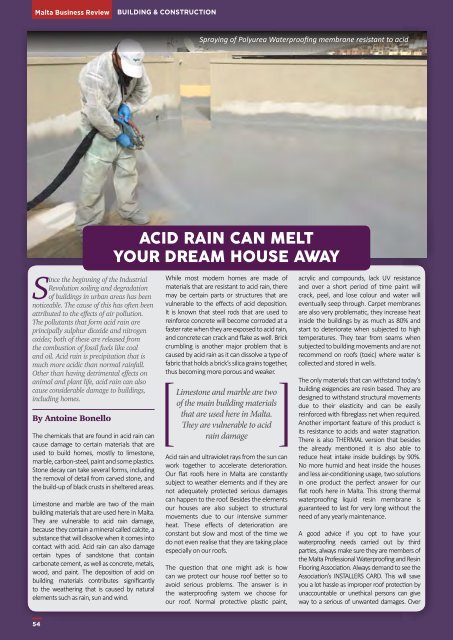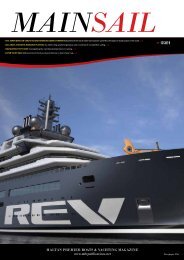MBR_ISSUE 40_Lowres
You also want an ePaper? Increase the reach of your titles
YUMPU automatically turns print PDFs into web optimized ePapers that Google loves.
Malta Business Review<br />
BUILDING & CONSTRUCTION<br />
Spraying of Polyurea Waterproofing membrane resistant to acid<br />
ACID RAIN CAN MELT<br />
YOUR DREAM HOUSE AWAY<br />
Since the beginning of the Industrial<br />
Revolution soiling and degradation<br />
of buildings in urban areas has been<br />
noticeable. The cause of this has often been<br />
attributed to the effects of air pollution.<br />
The pollutants that form acid rain are<br />
principally sulphur dioxide and nitrogen<br />
oxides; both of these are released from<br />
the combustion of fossil fuels like coal<br />
and oil. Acid rain is precipitation that is<br />
much more acidic than normal rainfall.<br />
Other than having detrimental effects on<br />
animal and plant life, acid rain can also<br />
cause considerable damage to buildings,<br />
including homes.<br />
By Antoine Bonello<br />
The chemicals that are found in acid rain can<br />
cause damage to certain materials that are<br />
used to build homes, mostly to limestone,<br />
marble, carbon-steel, paint and some plastics.<br />
Stone decay can take several forms, including<br />
the removal of detail from carved stone, and<br />
the build-up of black crusts in sheltered areas.<br />
Limestone and marble are two of the main<br />
building materials that are used here in Malta.<br />
They are vulnerable to acid rain damage,<br />
because they contain a mineral called calcite, a<br />
substance that will dissolve when it comes into<br />
contact with acid. Acid rain can also damage<br />
certain types of sandstone that contain<br />
carbonate cement, as well as concrete, metals,<br />
wood, and paint. The deposition of acid on<br />
building materials contributes significantly<br />
to the weathering that is caused by natural<br />
elements such as rain, sun and wind.<br />
While most modern homes are made of<br />
materials that are resistant to acid rain, there<br />
may be certain parts or structures that are<br />
vulnerable to the effects of acid deposition.<br />
It is known that steel rods that are used to<br />
reinforce concrete will become corroded at a<br />
faster rate when they are exposed to acid rain,<br />
and concrete can crack and flake as well. Brick<br />
crumbling is another major problem that is<br />
caused by acid rain as it can dissolve a type of<br />
fabric that holds a brick’s silica grains together,<br />
thus becoming more porous and weaker.<br />
Limestone and marble are two<br />
of the main building materials<br />
that are used here in Malta.<br />
They are vulnerable to acid<br />
rain damage<br />
Acid rain and ultraviolet rays from the sun can<br />
work together to accelerate deterioration.<br />
Our flat roofs here in Malta are constantly<br />
subject to weather elements and if they are<br />
not adequately protected serious damages<br />
can happen to the roof. Besides the elements<br />
our houses are also subject to structural<br />
movements due to our intensive summer<br />
heat. These effects of deterioration are<br />
constant but slow and most of the time we<br />
do not even realise that they are taking place<br />
especially on our roofs.<br />
The question that one might ask is how<br />
can we protect our house roof better so to<br />
avoid serious problems. The answer is in<br />
the waterproofing system we choose for<br />
our roof. Normal protective plastic paint,<br />
acrylic and compounds, lack UV resistance<br />
and over a short period of time paint will<br />
crack, peel, and lose colour and water will<br />
eventually seep through. Carpet membranes<br />
are also very problematic, they increase heat<br />
inside the buildings by as much as 80% and<br />
start to deteriorate when subjected to high<br />
temperatures. They tear from seams when<br />
subjected to building movements and are not<br />
recommend on roofs (toxic) where water is<br />
collected and stored in wells.<br />
The only materials that can withstand today’s<br />
building exigencies are resin based. They are<br />
designed to withstand structural movements<br />
due to their elasticity and can be easily<br />
reinforced with fibreglass net when required.<br />
Another important feature of this product is<br />
its resistance to acids and water stagnation.<br />
There is also THERMAL version that besides<br />
the already mentioned it is also able to<br />
reduce heat intake inside buildings by 90%.<br />
No more humid and heat inside the houses<br />
and less air-conditioning usage, two solutions<br />
in one product the perfect answer for our<br />
flat roofs here in Malta. This strong thermal<br />
waterproofing liquid resin membrane is<br />
guaranteed to last for very long without the<br />
need of any yearly maintenance.<br />
A good advice if you opt to have your<br />
waterproofing needs carried out by third<br />
parties, always make sure they are members of<br />
the Malta Professional Waterproofing and Resin<br />
Flooring Association. Always demand to see the<br />
Association’s INSTALLERS CARD. This will save<br />
you a lot hassle as improper roof protection by<br />
unaccountable or unethical persons can give<br />
way to a serious of unwanted damages. Over<br />
54

















